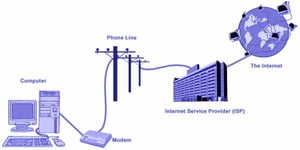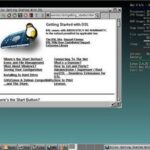Leaselines
- • Leaselines is a dedicated connection, meaning that it is permanently connected to the Internet. This is useful for web servers or other computers than need to be connected to the Internet all the time.
- • Leased lines are expensive and are generally used only by companies whose business is built around the Internet or need to transfer massive amounts of data.
DSL
- • Stands for Digital Subscriber Loop is a technology for bringing high-bandwidth information to homes and small businesses over ordinary copper telephone lines
- • DSL line carries both voice and data, you don’t have to install another phone line. You can use your existing line to establish DSL service, provided service is available in your area and you are within the specified distance from the telephone company’s central switching office.
- • Typically with DSL, data is downloaded to your computer at rates up to 1.544 Mbps and you can send data at 128 Kbps
- A cable modem is a new type of modem that hooks up your computer to a local cable TV line and provides internet access.
- A cable modem is more accurately described as a network interface card. Cable modems run over coaxial cable which allows much faster data transfer rates than phone wiring. Cable modem connections are digital – not analog.
- The actual bandwidth of a cable modem is up to 27 Mbps on the receiving end and about 2.5 Mbps on uploads or interactive responses. There is a catch, your speed will likely be around 1.5 Mpbs since your local cable company may not be connected on a line faster than a T-1. This is still FAST compared to a regular phone modem
- · There are only two drawbacks to cable. First, it is a shared connection, meaning you share the “pipeline” with your neighbors. That doesn’t mean that your neighbors will know what you are doing on the Internet. But it does mean that if all of your neighbors were on the Internet downloading large files at the same time, your Internet connection would not be as speedy as usual. In actuality, this won’t have any noticeable impact on a neighborhood until a lot more folks start using cable modems. The second drawback to cable is also minor. Because cable modem connections are always on, they, like DSL connections, make you more vulnerable to hacking and security breaches. For this reason, many cable companies are now providing their customers firewall software to help protect their security.
ISDN
- • Stands for Integrated Services Digital Network
- • ISDN service is an older, but still viable technology offered by phone companies in some parts of the U.S. ISDN requires a so-called ISDN adapter instead of a modem, and a phone line with a special connection that allows it to send and receive digital signals.
- • An ISDN line has a data transfer rate of between 57 Kbps and 128 Kbps
Dial Up Connection
The most basic type of Internet connection is called a dial-up connection. This connection is made through a modem (the communication mechanism in computers) that uses a telephone line to connect to the Internet. The modem must dial the telephone every time it wants to connect to the Internet, hence the name dial-up connection.
The fastest modem that you can use for this type of Internet connection is called a 56K modem. When a regular analog telephone line is used for an Internet connection, the modem must convert the analog signals that it receives from the telephone line into digital signals that the computer can comprehend. To send information from your computer, the modem must take the computer’s digital signals and convert them into analog signals to be sent over the telephone line. All of these conversions take time; compared to other Internet connections, this is a relatively slow connection. One other problem with this type connection is that calling the Internet will tie up your telephone line often forcing frequent users to bear the cost of installing and paying the monthly fees for a second telephone line.
Satellite/Wireless Connection
Satellite (HST) This is the most expensive alternative for getting a high-speed connection to the Internet. If you live in a rural area or a spot where other options are not available (as I do), then this is probably your only hope for a high-speed connection. These come in two varieties, 1-way and 2-way. One-way satellites are like television receivers: they only accept signals. You’ll still have to use your modem to connect for uploads. A 2-way connection, however, both sends and receives and is telephone-free.
Average speeds for this type of connection are 600K and higher for download and 128K for the upload. Averages tend to be higher because there are far fewer users on the network to slow things down. The biggest up side to this technology is that it is available just about everywhere. The biggest downside to this type of connection is two-fold: price and reliability. Expect to spend $600 or more for the equipment and another $50 or more a month for the connection. You’ll also experience down time (which will not be reimbursed by the ISP) during severe weather (called “rainouts”). Most satellite providers provide a dialup backup service as a part of their plan.




